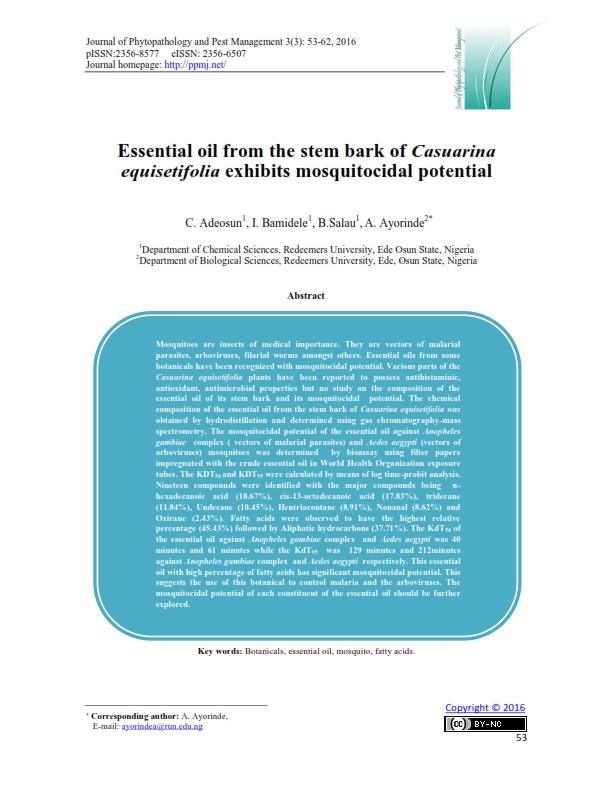Essential oil from the stem bark of Casuarina equisetifolia exhibits mosquitocidal potential
Keywords:
Botanicals, essential oil, mosquito, fatty acidsAbstract
Mosquitoes are insects of medical importance. They are vectors of malarial parasites, arboviruses, filarial worms amongst others. Essential oils from some botanicals have been recognized with mosquitocidal potential. Various parts of the Casuarina equisetifolia plants have been reported to possess antihistaminic, antioxidant, antimicrobial properties but no study on the composition of the essential oil of its stem bark and its mosquitocidal potential. The chemical composition of the essential oil from the stem bark of Casuarina equisetifolia was obtained by hydrodistillation and determined using gas chromatography-mass spectrometry. The mosquitocidal potential of the essential oil against Anopheles gambiae  complex ( vectors of malarial parasites) and Aedes aegypti (vectors of arboviruses) mosquitoes was determined by bioassay using filter papers impregnated with the crude essential oil in World Health Organization exposure tubes. The KDT50 and KDT95 were calculated by means of log time-probit analysis. Nineteen compounds were identified with the major compounds being n-hexadecanoic acid (18.67%), cis-13-octadecanoic acid (17.83%), tridecane (11.84%), Undecane (10.45%), Hentriacontane (8.91%), Nonanal (8.62%) and Oxirane (2.43%). Fatty acids were observed to have the highest relative percentage (45.43%) followed by Aliphatic hydrocarbons (37.71%). The KdT50 of the essential oil against Anopheles gambiae complex and Aedes aegypti was 40 minutes and 61 minutes while the KdT95 was 129 minutes and 212minutes against Anopheles gambiae complex and Aedes aegypti respectively. This essential oil with high percentage of fatty acids has significant mosquitocidal potential. This suggests the use of this botanical to control malaria and the arboviruses. The mosquitocidal potential of each constituent of the essential oil should be further explored.
Metrics

Published
How to Cite
Issue
Section
License
Authors who publish with Journal of Phytopathology and Disease Management agree to the following terms:
- Authors retain copyright and grant the journal right of first publication with the work simultaneously licensed under a Creative Commons Attribution License that allows others to share the work with an acknowledgement of the work's authorship and initial publication in this journal.
- Authors retain copyright and grant the journal right of first publication with the work simultaneously licensed under the Creative Commons Attribution-Non Commercial License (CC BY-NC). This allows others to share the work with an acknowledgement of the work's authorship and initial publication in this journal.
- Archives of Agricultural Sciences Journal is an Open Access Journal, and articles published are distributed under the terms of the Creative Commons Attribution-Non Commercial License (CC BY-NC). Readers may copy, distribute, and display the work for non commercial purposes with the proper citation of the original work. However, the journal retains the right to exploit subsidiary rights on behalf of the authors.
- Authors are able to enter into separate, additional contractural arrangements for the non-exclusive distribution of the journal's published version of the work (e.g. post it to an institutional repository or publish it in a book), with an acknowledgement of its initial publication in this journal.
- Authors are permitted and encouraged to post their work online (e.g., in institutional repositories or on their website) prior to and during the submission process with full disclosure to the journal, as it can lead to productive exchanges, as well as earlier and greater citation of published work. Following publication in Archives of Agricultural Sciences Journal, the author should update the repository, and include a citation and link to the published work.
Click here for more information on Licensing policy
.png)




